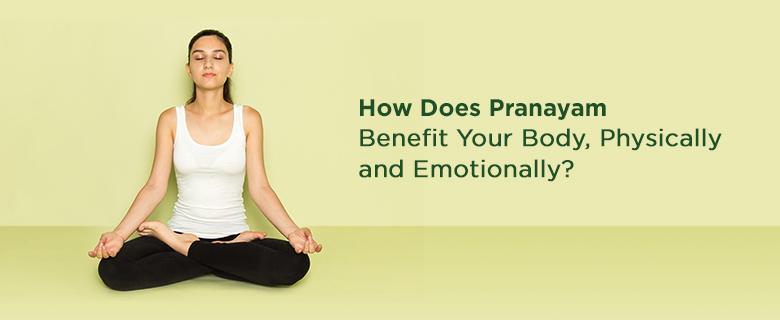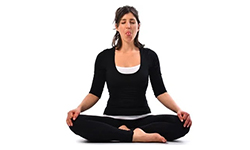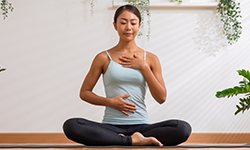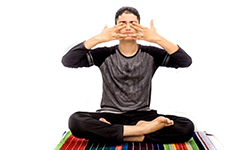
How Does Pranayam Benefit Your Body, Physically and Emotionally?
The huffing and puffing you do in the gym to remain in great shape can be made easier. Much easier. You’ll just need a yoga mat and 10 mins of your day for Pranayama – a deep breathing exercise that’s your gateway to a healthier life. In fact, it is more than just your typical workout. It’s a combination of four components:

Posture

Breathing practices

Deep relaxation

Meditation
To attain holistic wellbeing in a more proactive manner, look no further than the time-tested and effective practice of Pranayama. This form of exercise has its roots tracing back to India’s ancient science of holistic healing, Ayurveda. Before we explore Pranayama’s benefits on the mind, body, and soul, let’s unravel its origins.
Pranayama: The yogic art of breathing
The name Pranayama comes from the root words prana and Ayama. Prana means “life force,” and Ayama means “expansion, manifestation, or prolongation.” The practice of Pranayama, therefore, is the practice of expanding our own prana so that it harmonizes with the universal prana.
The Health Benefits Beyond the Mat
Ancient scrolls read that deep breathing helps in harnessing the power of positivity. This force impacts our wellbeing in all its expressions – mind, body, souls – and stems out far-reaching benefits and helps you:
- Enjoy better sleep
- Lower blood pressure
- Relieve muscle and back pain
- Sharper brain
- Enhanced immunity against disease
- Calm the nerves
- Improve mental wellbeing
Let’s segregate these benefits into two:
| Physical Benefits | Psychological Benefits |
|---|---|
| All types of breathing exercises can enhance your strength, flexibility, and balance. | Practicing Pranayama for Vata dosha daily gives way to more lasting changes by cultivating greater mind-body awareness. Helping you become more in tune with how your daily habits affect how you feel. |
| Practicing Pranayama regularly corrects abnormal breathing and reduces muscle tone of respiratory muscles. | Yoga also may make it easier to quit other unhealthy habits, such as smoking and excessive drinking, which people often use to cope with stress. |
| It provides more oxygen to the blood, relieves stress and reduces anxiety which together helps in improving immunity. | |
| Apart from that, Prayaam fosters better sleep, which translates into a host of health benefits, including better heart health and reduced obesity. | |
| Pranayam helps in lowering heart rate thereby reducing the risk of cardiovascular issues. | |
| Slow breathing in this form of yoga helps lower blood pressure and calms the nervous system. |
A closer look at the breadth of Pranayama exercises
There are many types of breathing exercises. We’ve highlighted the 5 easy ones that you can practice daily.
#1 Straw breath/ Sitali or Sitkari Pranayama
 How : Breath deeply through the nose and slowly exhale through the mouth as if there is an invisible straw in your mouth.
How : Breath deeply through the nose and slowly exhale through the mouth as if there is an invisible straw in your mouth.
Why : It is easy to learn and practice. It helps lower blood pressure and calms the nerves momentarily.
When : Any time you feel anxious, you can do straw breath- even with your eyes open!
#2 Belly Breathing (diaphragmatic breathing, dai-uh-fruh-ma-tuhk) / Dirga Pranayama
 How : Lie on your back on a flat surface, place one hand on your upper chest and the other on your belly, and breathe in slowly through your nose. Practice for five to 10 minutes, several times a day if possible.
How : Lie on your back on a flat surface, place one hand on your upper chest and the other on your belly, and breathe in slowly through your nose. Practice for five to 10 minutes, several times a day if possible.
Why : Belly breathing slows down the heartbeat, helps the lungs work more efficiently over time, and experience an increase in wellbeing.
When : Always on an empty stomach, right before bed is the best time, but other times are ok too.
#3 Bee Breath (Bhramari, Brah-mah-Ree)
 How : With eyes closed, spine straight, gently place your fingers on the cartilage flap where your cheek and ear meet. Take a deep breath in and exhale, making a humming sound like a bee while gently pressing the cartilage in and out with your fingers. The higher the pitch of your humming sound, the better the results. Inhale and continue 5-9 times.
How : With eyes closed, spine straight, gently place your fingers on the cartilage flap where your cheek and ear meet. Take a deep breath in and exhale, making a humming sound like a bee while gently pressing the cartilage in and out with your fingers. The higher the pitch of your humming sound, the better the results. Inhale and continue 5-9 times.
Why : It helps to instantly calm ourselves. Great for the times you feel extreme anger.
When : This breathing technique should be done on an empty stomach, as needed- up to 9 times a day!
#4 Victory Breath (Ujjayi, Ooh-Jai)
 How : Keep your mouth closed. Constrict your throat to the point that your breathing makes a rushing noise, almost like snoring. Control your breath with your diaphragm. Keep your inhalations and exhalations equal in duration.
How : Keep your mouth closed. Constrict your throat to the point that your breathing makes a rushing noise, almost like snoring. Control your breath with your diaphragm. Keep your inhalations and exhalations equal in duration.
Why : It can help ease you into sleep when you do just 10 long Ujjayi breaths in bed.
When : Anytime. Preferably before sleeping.
#5 Alternate Nostril Breathing (Nadi Shodhan, Nah-dee Sho-dun)

How : Keep pinky fingers of the right hand on the left nostril and exhale through the right. Repeat the opposite for the right nostril.
Why : It can help reduce stress and fatigue as well as balance the left and right sides of the brain.
When : It is especially good to do it before meditation. It is also good to do before any high-stress situations.
Takeaway
These yoga practices are not about incorporating heavy workouts into our daily lives or doing more. On the contrary, they’re more about undoing – relaxing the mind, releasing the stress, and letting go. Pranayama techniques offer you a slow and steady route to better health and fitness that can make a world of difference with everyday practice.
Put centuries of proven healing success into practice with Ayuvi
Ayuvi is a platform designed to help people proactively address their ailments and achieve overall wellness through a combination of the ancient science of Ayurveda, Ayurvedic medication, modern technology, and specialized guidance from doctors. Connect with vaidyas and nutritionists at Ayuvi who teach you how Pranayama and other Ayurveda teachings can improve the quality of life. While also guiding you every step of the way.





0 Comment
No comments found.Thank you. Your comment will be visible after an approval.
Add your comment